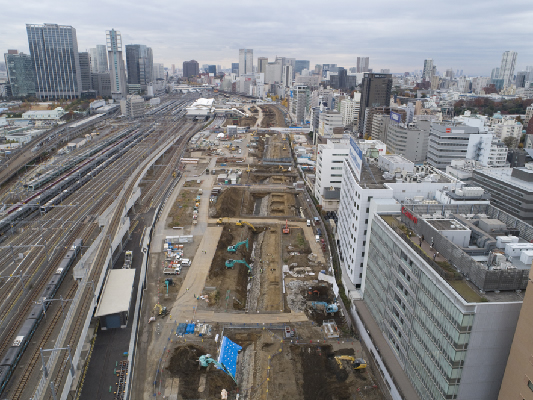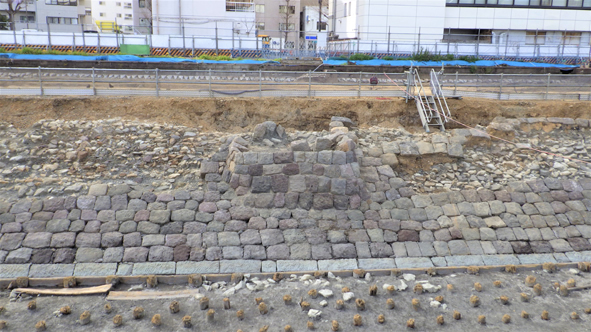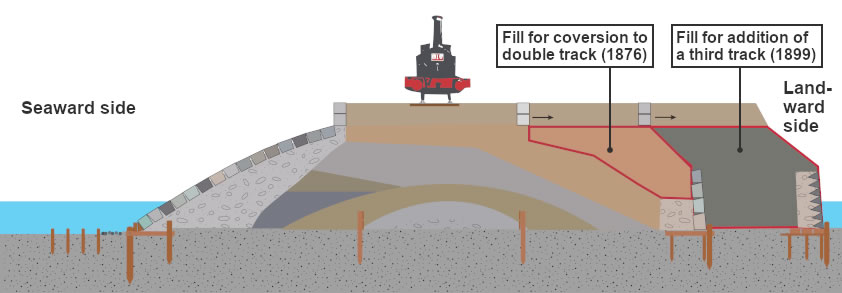Minato Ward, Tokyo Prefecture
Meiji Period (latter portion, nineteenth century)

Abutments for Bridge No. 7 of the Takanawa Chikutei A bridge built on the embankment. It was the seventh such bridge, counting from Shimbashi. It is thought to have been put in place to maintain a water route for boats going out to Tokyo Bay. The width between opposing abutments was approximately 6.8 m. Adapted from Hakkutsu sareta Nihon rettō 2022 [Excavations in the Japanese Archipelago, 2022] (Bunkachō [Agency for Cultural Affairs], ed., Kyodo News, 2022).

The Takanawa Chikutei viewed from above The embankment makes a gentle curve following the former Takanawa coastline. Shinagawa is toward the rear of the photo.

Railway signal foundation (from the east) The bulge in the stone paving visible at center is the foundation. Its position is approximately 900 m towards Shimbashi from Shinagawa Station. There were signals set up at 16 locations between Shimbashi and Shinagawa.

Internal structure of Takanawa Chikutei (schematic diagram) A hard clay layer was packed down at the very bottom of the embankment’s center, above which layers of silty soil were mounded, forming the core material. Also, it is thought that with an eye toward the seaward (eastern) side, after piling up clay, loam, and backfill stone in stages, stone blocks were likewise piled up in stages. On the landward (western) side, earthen fill and retaining walls from the periods of expansion were also ascertained. Adapted from Hakkutsu sareta Nihon rettō 2022 [Excavations in the Japanese Archipelago, 2022] (Bunkachō [Agency for Cultural Affairs], ed., Kyodo News, 2022).

Railway teapot A type of vessel for tea sold together with boxed lunches at railway stations. A steam train is drawn on this example in underglaze iron, and the bottom bears an inscription of the character 福 (fortune). Recovered at the Former Shimbashi Station. Largest diameter (including the spout): 12 cm.
Japan’s first railroad, which ran on a dike built over the sea
An embankment drawn in woodblock prints appears before our eyes
The Former Shimbashi Station and Takanawa Chikutei (embankment), a nationally designated Historic Site, are remains of the first railroad in Japan, which began operations between Shimbashi and Yokohama in the year Meiji 5 (1872). In excavations conducted since 1991, the foundations of the former Shimbashi Station, and its platforms and so forth were discovered, and in 1996 these were designated as the Site of the Former Shimbashi Station, a national Historic Site.
At the time the Shimbashi–Yokohama railroad opened, the railway was laid atop a dike built over the sea for a 2.7-km stretch from north of modern Tamachi Station to the south of Shinagawa Station. This dike is called Takanawa Chikutei. Until recently Takanawa Chikutei was thought to have been torn down and thus as not surviving, but starting with the discovery of a portion of stone retaining wall during construction in 2019 for improving Shinagawa Station, it has been learned that the fill of the embankment plus its stone facing and so forth have survived in good condition for a considerable north–south stretch, and full-scale excavation has been conducted from 2021.
The embankment has a structure of a dike built of piled earth, retained on both sides by stone facing. The stone facing was on an incline of 30 degrees on the seaward side, and piled up nearly vertically on the landward face. The seaward retaining wall had rectangular foundation stones of 90 cm width laid as its lowermost tier, on top of which dressed stones 50 cm on a side were piled up. At the time of its opening the railway was single track, and the embankment was slightly more than 6 m wide at its top, 17.5 m wide at its base, and slightly less than 4 m in height in scale. The base was under water at about 1 m below sea level, and the front face of the seaward stonewall had a row of wooden piles driven down to reinforce the weak ground base. Traces of widening the embankment for the conversion to a double-track railway in the year Meiji 9 (1876) were also confirmed. Bridge abutments built with piled dressed stone were also discovered (for the No. 7 bridge). This appears to have been made to allow passage of boats into Tokyo Bay, and the image of a steam train passing over this bridge is depicted in many woodblock prints. In addition, another piled stone feature atop a portion of the stone wall on the seaward side was found, thought to be the foundation for erecting a railway signal.
Railway features relating Japan’s modernization
In the excavations of Takanawa Chikutei thus far, double-headed rails and timber sleepers (ties) and so forth have been found, along with tickets and ticket punches used at the wickets, in the excavation of the Former Shimbashi Station, from which we can glimpse the conditions from the time when the first railroad was built in Japan.
At present, the original station building and platform of the Former Shimbashi Station have been restored as one part of the major urban redevelopment project, the Shiodome Sho-site, which lies in between JR Shimbashi Station and the Former Hama-rikyū Gardens (nationally designated as a Special Historic Site and Special Place of Scenic Beauty). On the other hand, the excavation of the Takanawa Chikutei site is still underway, as of April 2022, and from the investigation thus far the internal structure and method of construction of the embankment have been coming to light. As these results are vital for knowing the history of the modernization of Japanese transport, and of the civil engineering technology that was involved, in 2021 a portion of Takanawa Chikutei was newly added to the National Historic Site designation of the Former Shimbashi Station, which was re-designated as the Former Shimbashi Station Site and Takanawa Chikutei Site. (Hirakōchi Tsuyoshi)

